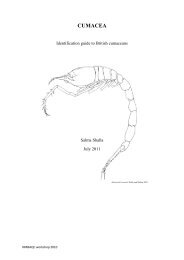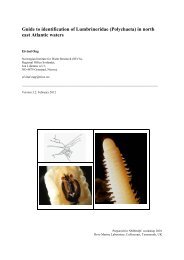s A Field Guide to the British Seaweeds - NMBAQC
s A Field Guide to the British Seaweeds - NMBAQC
s A Field Guide to the British Seaweeds - NMBAQC
You also want an ePaper? Increase the reach of your titles
YUMPU automatically turns print PDFs into web optimized ePapers that Google loves.
Chae<strong>to</strong>morpha linum<br />
This is an unbranched filament with a reticulate or<br />
network-like chloroplast which generally fills <strong>the</strong><br />
whole cell with colour with numerous pyrenoids<br />
present within each cells. The cells tend <strong>to</strong> be as<br />
long as broad or slightly longer and are often<br />
barrel shaped. This species of Chae<strong>to</strong>morpha has<br />
a filament width of between 100-300um. It takes<br />
<strong>the</strong> appearance of thick, <strong>to</strong>ugh, wiry floating<br />
masses, like green garden wire or wire wool and is<br />
located on <strong>the</strong> upper or mid shore on open rock<br />
surfaces or in shallow rockpools and often in<br />
dense clumps. It may form mat-like blooms on soft<br />
sediments in estuaries<br />
Dense clumps of Chae<strong>to</strong>morpha<br />
linum appearing as <strong>to</strong>ugh wiry<br />
masses<br />
Large cells filled with reticulate<br />
chloroplast




